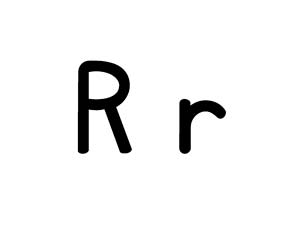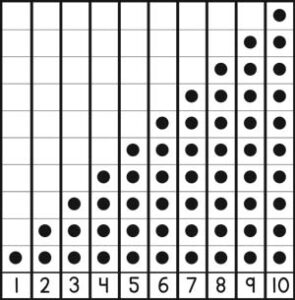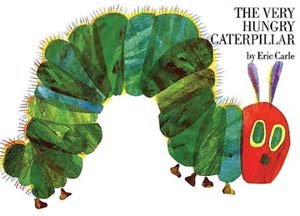Oral language, Letter knowledge
Children will interpret information presented in a book read aloud and increase the number of novel words they understand. Children will also identify and say the sound of the letter R.


New:
Review:
Be Prepared: This is the third of three repeated readings of a book with children. Today’s session focuses on children’s interpretation (explanations, reasoning) of information presented in the book. The session also will help children understand more novel words. From the list of novel words you identified prior to your first reading of the book, select 2–3 words to define for children today. See the Language/Literacy section of the ELM User Guide: 3–5 Years for additional information on how to select and define novel words.
 [Display letter R card.]
[Display letter R card.]
What is the name of this letter? What sound does the letter R make?
Letter R says /r/, just like in the word “relax.” /r/, /r/, relax. Let’s together say /r/, /r/, relax.
Now let’s spend some time with our book.
[See Week 3, Day 5 of Language/Literacy for a description and examples of how to approach today’s book reading. Key aspects are summarized below:
Number knowledge
Children will find the number that is one more than another number, and determine which of two numbers is more.


Review:
We are learning to find the number that is one more than another number. We know the number that is one more than another number is the number after that number.
Let’s imagine that we have five frogs. Each frog has a number on its back. The first frog has number one on its back. The second frog has number two on its back. The third frog has number three on its back. The fourth frog has number four on its back.
What number would the next frog have on its back?
Number five is one more than number four!
We also are learning how a number chart can help us find the number that is one more than another number.
[Display a number chart.]
 Let’s look at our chart with numbers and dots.
Let’s look at our chart with numbers and dots.
We read a book called The Very Hungry Caterpillar by Eric Carle to help us learn more about one more.
The caterpillar in our book ate many things in the book. We read that on Wednesday the caterpillar ate through three plums.
 [As you ask the following questions, display the corresponding page in the book and lead children in counting the items.]
[As you ask the following questions, display the corresponding page in the book and lead children in counting the items.]
[Display the line of numbers used on Day 4.]
We also played a game this week. We chose a number from a basket and then placed a beanbag on the number that was one more than the number we chose from the basket. Let’s practice our game again.
[Invite a volunteer child to choose a numeral card from the basket. Encourage the other children to determine which numeral is one more than the numeral chosen. Invite the volunteer to place a beanbag on the numeral that is one more.]
We also know how to figure out which of two numbers is more.
[Hold up small numeral cards two and eight.]
I am holding up two numbers. Which number is more? Use the number chart if you need help. Let’s try two more numbers.
[Continue comparing two different numerals as children determine which one is more. Compare numerals four and nine, numerals one and five, and numerals seven and 10.]
This week we practiced finding the number that is one more than another number. We also determined which of two numbers was more.
Extra support
Enrichment
Supply paper and markers or colored pencils. Invite children to draw a collection of 1–10 items.
With children, take a trip to the local library to look for counting books. Encourage school-age children to share the books with younger children while practicing the concept of one more.
Motor development
Children will practice jumping over an object.


Review:

Be Prepared: Place the string or rope on the floor in parallel lines, six (or fewer) inches apart. If additional adult assistance is available, you may wish to set up two jumping stations that can be used at the same time.
Yesterday we practiced jumping. Remember, when we jump, our body leaves the floor (or ground) for a short time and comes down to the floor (or ground). We land on both of our feet. Let’s all jump forward once and then backward once. Remember to stay in your personal space.
Today we will practice jumping over the two pieces of string that are on our floor. Each of us can try to jump over the string without our feet touching the string. We will take turns. We will jump forward.
[Point to the two lines of string.]
We can put our toes next to one of the strings and then jump forward.
[Demonstrate jumping over the string.]
[Provide each child an opportunity to jump over the string. Provide as many turns as time permits.]
Let’s make our jumping practice a little harder. I am going to move the string farther apart. Then each of us can try to jump over both pieces of string.
[Provide each child with an opportunity to jump. As time and interest allows, continue to move the string pieces further apart.]
Today we practiced jumping and landing on our feet. We practiced jumping over two pieces of string on the floor. We moved the string so we had to jump further.
Extra support
Enrichment
For outdoor play, provide a variety of safe objects (baseball bases, jump ropes, etc.) for children to jump over individually or with a partner. Arrange the different objects into a jumping course.
Create a jumping course in an outside play area. Provide an increasing difficulty level of things to jump over.
Exploring Where We Live
Social Studies
Skill and Goal
Knowledge of social and physical environments
Children will broaden their understanding of geographic characteristics found in their community.
Materials
Needed
Key
Concepts
Review:
Also
Promotes
[Arrange children sitting in a circle around a large floor rug or open area. Give each child the geographic characteristic he/she made in Week 20.]
We are learning about the characteristics of our community’s geography. Last week we made different types of characteristics we can find in our community. Please look around our circle at the different things we made.
[Name the categories of geographic characteristics children made: bridges, railroad tracks, etc. If there are many different forms of water, consider combining these into one category (water) for efficiency in the activity’s song singing described below.]
Listen carefully as I sing the song.
[Sing the song as you hold up a geographic characteristic made by a child. Example: “A bridge in our community, community, community. A bridge in our community, yes, that’s what we will find!”]
Our first characteristic is a bridge. If you made a bridge, please stand up!
Let’s each place our bridge on the rug/floor. We can place our bridge wherever we would like on the rug/floor.
[Invite all children who made a bridge to place it on the rug/floor and then sit down.]
Now let’s sing our song. We can sing about a bridge in our community!
[Lead children in singing the song about a bridge in their community. Continue choosing one type of geographic characteristic made by children and inviting all children who made the specific type of characteristic to place it on the rug/floor. Sing the song using the name of the characteristic.]
Today we sang a song about the geography of our community. We can find many things in a community!
Scaffolding Tips
Extra support
Enrichment
Center Activity
Invite children to put their geographic characteristic in the block center. Add toy cars, trucks, and people figures to extend children’s play. Invite children to sing the song from today’s activity as they play.
Family Child Care
Encourage children to teach their families the community song at pickup time. Invite children to sing about different geographic characteristics.